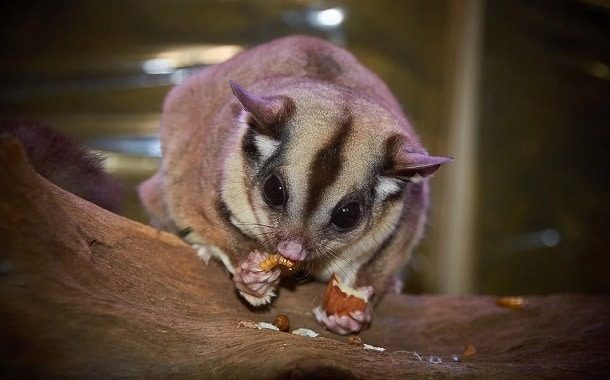How Much Do Sugar Gliders Cost?
Last Updated on December 26, 2023
Written by CPA Alec Pow | Content Reviewed by ![]() CFA Alexander Popinker
CFA Alexander Popinker
Sugar gliders, also referred to as sugar bears and honey gliders are little marsupials coming from Australia that are becoming typical exotic family pets in the United States. They have gray, black, or cream fur, pouches, and a “sliding membrane” in between their front and back legs that enables them to slide through the air. But how much do sugar gliders cost?
How Much Does a Sugar Glider Cost?
Purchasing a baby sugar glider, or joey, aged 8 to 12 weeks, will cost somewhere between $200 and $500, depending upon the geographical area, the pet’s character, and other characteristics of interest.
The initial costs involved with the purchase of sugar gliders that are older are somewhat smaller, anywhere between $100 and $150 due to the fact that they’ll be more difficult to train and are for that reason less wanted.
Search for a USDA-licensed breeder.
What should you expect to get with the sale?
 Typically confused with flying squirrels, they are different from those mammals because gliders are more social and live two times as long – about 12 to 15 years.
Typically confused with flying squirrels, they are different from those mammals because gliders are more social and live two times as long – about 12 to 15 years.
The Association of Sugar Glider Veterinarians offers a guide on what to anticipate when bringing a sugar glider into your home.
Before you purchase a sugar glider, be sure that its eyes are bright and very shiny, its tail is totally furred and its coat is soft, not rumpled. Also, make certain no animals in the very same cage look ill in any way.
Check out the pet’s character to ensure it will be a good fit for your family. Sugar gliders need to be well interacted with socially when on the market. Ensure the pet is friendly around people and not skittish. Ask to hold it; a trustworthy seller will be ok with this.
Extra costs to be prepared for
A sugar glider-appropriate cage will have a price between $100 and $150 and will be large, at least 50 inches wide and 50 to 70 inches tall. Some great examples are the Jung-L-Gym Start-R-Cage offered at SugarGliderInfo.org for $139 or the best-selling sugar glider cage from Amazon which retails for a bit less than $100.
Sugar gliders love to have fun with almost any family pet toy, however, try to avoid those with strings, as they can get tangled in them. Toy costs vary from $2 to $20, depending on what you get.
You might also like our articles about the cost of a squirrel, a monkey, or an otter.
Due to the fact that the sugar glider’s natural environment is warm, it’s very much recommended that you get a heat rock or heat light to keep the glider’s cage as comfortable as possible. These will cost about $15 to $40. You should also add bedding to the cage, which shouldn’t cost more than $20.
What Do Sugar Gliders Eat?
The sugar glider is an omnivore exotic pet. It can eat everything from a raw sugar glider diet to commercial food, along with the occasional fruits and vegetables.
You will usually spend around $15 to $20 for the average bag of sugar glider food. This bag should be enough for around 3 to 4 weeks. When it comes to raw food, it will be somewhat more expensive than commercial food brands.
However, experts say that raw diets are a lot healthier for sugar gliders than commercial foods. When owning a sugar glider you will spend on average, you will have to spend roughly $35 to $40 per month on its food alone.
Feeding a sugar glider a diet plan of veterinarian-approved pellet food, fresh vegetables, and fruits and a calcium-based multivitamin supplement will probably cost about $40 monthly. Likewise, a water bottle and food dish will each run about $5. PetEducation has details on what food to feed a sugar glider.
Some shops, like the Association of Sugar Glider Veterinarians-approved SugarBears, use a glider starter set consisting of a one-month supply of food and vitamins, a heat rock, a water bottle, and a food bowl for $50.
Health Care
- $50-$100 per year
When you properly care for a sugar glider, it will be a fairly healthy animal that shouldn’t require any vaccinations. Although diabetes and obesity are common conditions these exotic pets suffer from, these can be mitigated almost completely through exercise and a proper diet.
When keeping multiple sugar gliders, both males and females together as a group, it isn’t a bad idea to have the males neutered. This will prevent you from having a cage full of babies.
This procedure shouldn’t cost more than $50 to $100 and is rather simple and painless for the animal. Spaying females, on the other hand, is a lot more complex and will be a procedure that a lot of vets won’t even want to perform.
Insurance
- $200-$250 per year
Considering that Sugar Gliders are exotic animals and that most Glider owners will choose to get a pair, pet insurance will also be particularly pricey. In a best-case scenario you’ll spend $10 on each per month, so expect an annual cost of at least $200 per year for a pair of gliders.
Considering that these pets are usually healthy, it would be better if you just saved the $200 for emergencies and stay away from insurance at least until the pet becomes older and sicker.
Check-Ups
- $50-$100 per year
As with any other pet and especially exotic animals, it is a good idea to make sure that your pet is growing properly and is overall healthy and the easiest way to do this is through annual checkups, even though annual vaccinations aren’t required.
Expect to pay around $50 for the typical checkup with a vet. During this checkup, complex tests or dental cleaning won’t be required.
Treatments for Parasites
- $15-$30 per year
Most domesticated gliders will have no problems with ticks or parasites, as you’d keep them most of their lives indoors, in a cage. Even so, it isn’t a bad idea to deworm them once a year, at least.
These kinds of treatments are made to be inexpensive, easy, and quick, usually setting you back just $15 or so per year.
Emergencies
- $100-$300 per year
When it comes to exotic pets, most veterinary clinics will have a limited set of services. This is why the costs for any emergency procedures might be pretty noticeable.
Although these are rather healthy pets, accidents might still happen. Put away the $200 you’d normally spend for insurance in a medical emergency fund and you should be fine.
Important things to consider
According to Sugar-Fliders.com, these creatures come in several color variations, among the most common are cremino, which is the creamy albino, with a white face, white tip, platinum and black face, and leucistic, which has black eyes and is white overall.
When in captivity, the lifespan of a sugar glider that is kept healthy is up to 15 years.
If you have small children around the house, then getting a sugar glider isn’t recommended, as these are some very fragile creatures. They can easily get hurt if a child were to drop them but at the same time, although friendly in nature, they might bite, which could leave quite a mark.
Despite their small size, they will also make considerable noise. They are day-sleepers, which means they will make a lot of noise throughout the night, like barking or screeching.
Searching for a sugar glider
Most people choose to buy a sugar glider either from a reputable online pet store or from a local breeder they found on marketplaces like Craigslist.
To stay safe, always try to adopt these types of pets from USDA-licensed breeders. In this way, you will be sure that you are working with someone who is reputable.
Remember that even USDA-licensed sellers might not be ethical or have the highest-quality sugar gliders for sale. So make sure you’re looking both at their breeding setup and their overall reviews online and offline to make sure they are providing healthy pets you will enjoy for a lot of years.
When possible, avoid getting pet sugar sliders from flea markets, pet shows, expos, or mall shops.
The Association of Sugar Glider Veterinarians (ASGV) and the North American Sugar Gliders Association both inform us that there is a lot of out-of-date and inaccurate information concerning the care of sugar gliders on the Internet. You should check their websites for the most reliable info.
The ASGV also provides a list of 7 questions to ask a sugar glider seller.
Keep in mind that sugar gliders, like other exotic animals, are prohibited in some cities and states, one of them being California. Check out regional regulations to see if sugar glider ownership is permitted and whether authorization is required, or not.
Ways to save money
Depending on where you live, you might be able to find a sugar glider rescue group in your area. This means that you will be able to get an older sugar glider for less than $100, just like you’d get a dog or a cat. If you’re going for this option, remember that adult sugar gliders are overall harder to train.
Owning a Sugar Glider on a Budget
Although some owners decide to keep gliders in smaller and overall cheaper cages and take them out daily for exercise, this isn’t something we’d recommend.
These animals are nocturnal, which means that you’d have to spend half a night awake to entertain their need for movement. Sugar gliders require a lot of space to move and climb, so a smaller cage will certainly make them sad. Honestly, instead of getting a Sugar Glider only to skimp on the cost related to a decent lifestyle, you should consider buying another pet that is cheaper.


Leave a Reply
Want to join the discussion?Feel free to contribute!